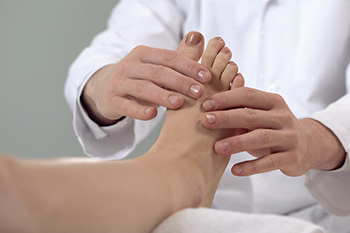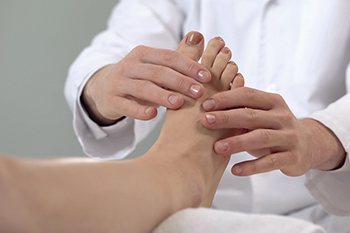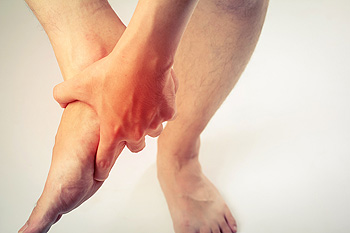
(616) 846-3400
Fax: (616) 846-3406

(616) 846-3400
Fax: (616) 846-3406

Many people may not know that there are two pea-shaped bones located under the big toe that are known as the sesamoids. When the tendons that are attached to these bones become inflamed from overuse of the front of the foot, a condition known as sesamoiditis can occur. Individuals with sesamoiditis can experience pain in the ball of their feet where the affected sesamoids are located, and they might find it difficult to point their toes. There are several things that a medical professional might do to diagnose a case of sesamoiditis. First, a physical examination will be performed on the affected area, analyzing the movement and flexibility of the big toe. If sesamoiditis is likely in a patient, then an X-ray might be performed to get a better sense of the state of the patient’s bones. In some cases, bone scans might be even more helpful, as these images make more things visible than X-rays. If you have sesamoiditis, do not hesitate to consult with a podiatrist.
Sesamoiditis is an unpleasant foot condition characterized by pain in the balls of the feet. If you think you’re struggling with sesamoiditis, contact Dr. Robbi Young of Grand Haven Foot & Ankle. Our doctor will treat your condition thoroughly and effectively.
Sesamoiditis
Sesamoiditis is a condition of the foot that affects the ball of the foot. It is more common in younger people than it is in older people. It can also occur with people who have begun a new exercise program, since their bodies are adjusting to the new physical regimen. Pain may also be caused by the inflammation of tendons surrounding the bones. It is important to seek treatment in its early stages because if you ignore the pain, this condition can lead to more serious problems such as severe irritation and bone fractures.
Causes of Sesamoiditis
Treatment for sesamoiditis is non-invasive and simple. Doctors may recommend a strict rest period where the patient forgoes most physical activity. This will help give the patient time to heal their feet through limited activity. For serious cases, it is best to speak with your doctor to determine a treatment option that will help your specific needs.
If you have any questions please feel free to contact our office located in Grand Haven, MI . We offer the newest diagnostic and treatment technologies for all your foot and ankle needs.

Gout is a form of arthritis, or inflammation, caused by a buildup of uric acid in the system. The main symptoms are redness, swelling, pain, and tenderness in a joint. The joint at the base of the big toe is commonly affected by gout. The range of motion in the joint decreases and even the slightest touch can cause extreme pain. Certain medications, dietary choices, drinking alcohol and sugary beverages, age, and genetics can play a part in the development of gout. Eating foods rich in purines, such as red meat and seafood, can increase the risk. People with diabetes, thyroid problems, and high blood pressure are also at a higher risk of gout. Men over 40 and menopausal women are more at risk as well. Medication and lifestyle changes are large factors in holding off gout. Corticosteroids and non-steroidal anti-inflammatory medications may be prescribed by a podiatrist to help reduce the pain and inflammation. In addition, certain medications can help to reduce uric acid production and eliminate it from the body. Please make an appointment with a podiatrist for additional treatment options for gout.
Gout is a painful condition that can be treated. If you are seeking treatment, contact Dr. Robbi Young from Grand Haven Foot & Ankle. Our doctor will treat your foot and ankle needs.
What Is Gout?
Gout is a form of arthritis that is characterized by sudden, severe attacks of pain, redness, and tenderness in the joints. The condition usually affects the joint at the base of the big toe. A gout attack can occur at any random time, such as the middle of the night while you are asleep.
Symptoms
Risk Factors
Prior to visiting your podiatrist to receive treatment for gout, there are a few things you should do beforehand. If you have gout you should write down your symptoms--including when they started and how often you experience them, important medical information you may have, and any questions you may have. Writing down these three things will help your podiatrist in assessing your specific situation so that he or she may provide the best route of treatment for you.
If you have any questions, please feel free to contact our office located in Grand Haven, MI . We offer the newest diagnostic and treatment technologies for all your foot care needs.

Many children develop a blister on their feet at least once during their youth. Blisters are a common condition that can develop on the feet. Blisters can form on the back of the heel for many people while wearing a new, ill-fitting pair of shoes because the shoes can persistently rub up against the heel. These blisters are essentially bubbles that form on the skin, and they can be filled with blood or pus. Besides friction, blisters can be caused by sunburns, insect bites, and burns, among other things. Although many cases of blisters do not require medical attention, you might consider seeing a medical professional under certain circumstances for your child. For example, if the skin around the blister has noticeable discoloration, it may be wise to consult with a podiatrist. It could be particularly problematic when the color of the skin changes to red, gray, or purple. In the same vein, when the skin surrounding a blister becomes tender to the touch, it might be time to schedule an appointment with a podiatrist. Lastly, if your child complains to you that their blisters have started producing a foul odor, this can also be a sign to seek medical guidance. Don’t take chances with your children’s blisters.
Blisters are prone to making everyday activities extremely uncomfortable. If your feet are hurting, contact Dr. Robbi Young of Grand Haven Foot & Ankle. Our doctor can provide the care you need to keep you pain-free and on your feet.
Foot Blisters
Foot blisters develop as a result of constantly wearing tight or ill-fitting footwear. This happens due to the constant rubbing from the shoe, which can often lead to pain.
What Are Foot Blisters?
A foot blister is a small fluid-filled pocket that forms on the upper-most layer of the skin. Blisters are filled with clear fluid and can lead to blood drainage or pus if the area becomes infected.
How Do Blisters Form?
Blisters on the feet are often the result of constant friction of skin and material, usually by shoe rubbing. Walking in sandals, boots, or shoes that don’t fit properly for long periods of time can result in a blister. Having consistent foot moisture and humidity can easily lead to blister formation.
Prevention & Treatment
It is important to properly care for the affected area in order to prevent infection and ease the pain. Do not lance the blister and use a Band-Aid to provide pain relief. Also, be sure to keep your feet dry and wear proper fitting shoes. If you see blood or pus in a blister, seek assistance from a podiatrist.
If you have any questions, please feel free to contact our office located in Grand Haven, MI . We offer the newest diagnostic and treatment technologies for all your foot care needs.

The foot condition known as plantar fibromatosis can also be referred to as Ledderhose disease. It is a rare condition where a nodule is embedded in the arch of the foot. It is often benign despite the pain and discomfort associated with it. One noticeable symptom of a plantar fibroma includes a firm lump in the arch of the foot, which may gradually increase in size. It can be caused by enduring a foot injury, frequently participating in running and jumping activities, or from taking certain medications. Having an MRI taken is often successful in diagnosing this condition and a biopsy may need to be performed. The pain may diminish when anti-inflammatory medications are taken as well as when orthotics are worn as they distribute the body’s weight more evenly. In severe cases when the plantar fibroma has significantly grown, surgery may be an option for permanent removal. If you suffer from this condition, it is advised that you seek the counsel of a podiatrist who can effectively guide you toward correct treatment techniques.
A plantar fibroma may disrupt your daily activities. If you have any concerns, contact Dr. Robbi Young of Grand Haven Foot & Ankle. Our doctor can provide the care you need to keep you pain-free and on your feet.
Plantar Fibroma
A plantar fibroma is a fibrous knot in the arch of the foot. It is embedded in the plantar fascia which is a band of tissue that extends from the heel to the toes along the bottom of the foot. There can be multiple plantar fibromas in the feet at the same time. There are no known causes for this condition. If you have a plantar fibroma, there will be a bump in the arch of your foot that cannot be missed. Any associated pain is most often due to a shoe rubbing against the nodule. Non-surgical options, such as steroid injections, physical therapy, and orthotics should be tried first. Surgery is a last resort and is the only thing that will remove a plantar fibroma entirely. Consult with a podiatrist for a proper diagnosis and to determine the treatment regimen that is right for you.
What Causes a Plantar Fibroma?
While there are no specific causes identified, a plantar fibroma can possibly come from genetic predisposition or the formation of scar tissue that forms from healing the tears in the plantar fascia.
What Are the Symptoms of a Plantar Fibroma?
There will be a noticeable lump in the arch of the foot that may or may not cause pain. If pain is felt, it is typically because a shoe is rubbing up against the lump or when walking or standing barefoot.
Treatment and Prevention
A plantar fibroma will not disappear without treatment, but it can get smaller and be a non-issue. If pain persists, a podiatrist examines the foot and when the arch of the foot is pressed, pain can be felt down to the toes. An MRI or biopsy might be performed to help diagnose or evaluate the plantar fibroma. The following non-surgical options are generally enough to reduce the size and pain of these nodules:
Surgery is considered if the mass increases in size and the patient continues to feel pain after non-surgical methods are tried.
If you have any questions please feel free to contact our office located in Grand Haven, MI . We offer the newest diagnostic tools and technology to treat your foot and ankle needs.